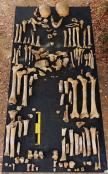CAMPAGNA 2018 |
1° SETTIMANA |
2° SETTIMANA |
3° SETTIMANA |
4° SETTIMANA |
5° SETTIMANA |
6° SETTIMANA |
7° SETTIMANA |
8° SETTIMANA |
9° SETTIMANA |
08 AGOSTO 2018 
Resoconto della giornata di scavo
Generale
In the last days of work, with the students of the second session, we proceeded to the cleaning, restoring and at last to the counting of minimum number of individuals present in the reduction layer USK 3330, belonging to the multiple lythic coffin USM 3321, excavated in Area 3000, in 2013. Based on the number of left tibial diaphyses, incompatible with a single skeletal element, we deduced a number of at least 7 adults. To these 7 individuals we summed an eighth one, deceased in early infant age, represented by two unfused pubic bones paired on the basis of skeletal development, incompatible with the other individuals due to the different growth degree and therefore age at death. The two pubic bones were incomplete but the maximum length that could be measured was about 32.4 mm that, according to Cardoso (2017), would be compatible with an individual of 1-2 years old. Other findings were a maxillary deciduous lateral incisor and a phalanx in growth, probably just residuals due to the lack of other recognizable elements.
In summary, we hypothesized a minimum number of 8 individuals present inside the reduction layer USK 3330: summing then the number of individuals in connection found inside the lythic coffin (USK 3329, 3360, 3373, 3375), we obtain a MNI of 12 people in all buried inside the multiple grave.
Thanks to the pelvic bones and skulls recovered, we suggested the presence of at least 2 adult females and 2 mature males (based on the evaluation of degenerative changes to the pubic symphyses and auricular surfaces).
From a paleopathological point of view, we observed the presence of several endo and ecto-cranial erosive lesions with rounded borders in two skulls: these erosions would be compatible with a strong inflammatory reaction. One of the two crania presented also some resorption on the tympanic roof of the two petrous bones and strong signs of chronic maxillary sinusitis: the association of these symptoms is probably linked to a common pathogen agent that must be further studied in depth.
Furthermore, two ulnae and a radius, paired based on the aspect and the very strong muscular insertions, presented an anomalous lateral curvature of the proximal third of the shaft: these changes are suggestive of a healed episode of juvenile rickets. Moreover, two cervicals (C2 and C3), pertaining to a gracile adult individual according to the dimension and fusion of the odontoid process of the axis, presented an ankylosis of the bodies, neural arches and apophyseal joints, probably linked to congenital cause, on the basis of the joint lines just barely visible.
In the picture is shown an overview of the total number of bones recovered, divided for type of bone, side and portion during the counting process.

THANKS to all the second session students for their thorough and enthusiastic job aimed to these interesting and promising results!
Area 3000
Today we continued to work on USK 30065. We first cleaned and defined the features and bones within the grave in order for photogrammetry. At this juncture, we also took points for GIS. After this we began to extract the skeletal elements from the grave; this is a very sped up process as the site is closing on Friday and the skeleton is too brittle to be left in the ground for next season. Although the bone is incredibly fragmented, we have managed to remove the entirety of the cranium, clavicles, right humerus and radius, as well as the bones of the left foot (fragmented calcaneus and other tarsals), the left patella, and both of the tibiae and fibulae. Work was progressing on removing the femurs as we left site.
Area 5000
Today, we closed Section A and B for the season by placing tarps on the entire area, by placing dirt and rocks to prevent it from flying away. Section D was troweled and cleaned, for photogrammetry to be taken. Finally, when Section D was pickaxed, too many items were found for the site to be closed. We will wait for tomorrow for a decision to be made, as to how to proceed.
Area 6000
(group 3000) today photos and points were taken of the margins of the lithic tomb and each intact or mostly intact bone in the first reduction later. We then began removing the scattered skeletal remains in the reduction us 6503 from fill 6551. Tomorrow the skeleton usk 6502 will be fully revealed, photographed, and removed and then the site will be closed for the regular school season.










